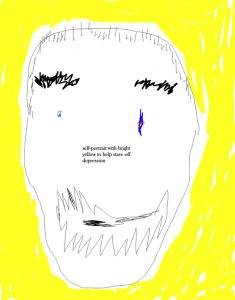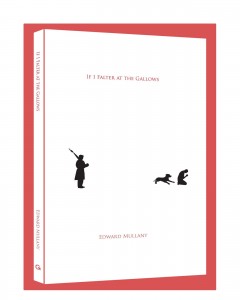Five Questions with Edward Mullany
Sophie Rosenblum: I’m continuously impressed in your writing by how undaunted you seem to be by blank space. How do you make space work for you, and what advice would you give to writers attempting to move in similar directions?
Edward Mullany: Blank space is most interesting to me when the writer uses it as a canvas onto which the reader’s imagination is projected. In other words, it should only look blank. Really it should function as a kind of invisible arena in which the reader’s psyche produces some feeling that the writer, by doing his or her work, has elicited.
Blank space exists in all art, whether we can see it or not. It sounds like a physical thing (and sometimes it is – on the page, for instance), but more importantly it’s a psychic space created by the artist for the purpose of contemplation. It’s where the audience’s mind goes to infer those things the artist has made it possible to infer.
SR: Your writing reveals a unique sense of humor. I repeatedly found myself laughing while reading If I Falter at the Gallows, but I was often unsure exactly what it was that was making me laugh. How do you classify the humor in these pieces? What makes Edward Mullany laugh?
EM: I think animals are funny because they have to coexist with humans. Domesticated animals especially are funny to me because they are, in many ways, unsophisticated, and yet they live so near to humans, who are capable of sophistication. I guess it’s not so much the animals themselves that make me laugh, but the situation that has resulted from our interaction with them. A bird sitting on a telephone wire. A cat staring out a bathroom window. A dog can have the appearance of a wolf, but there he sits, asleep on our living room couch. We can give him a name like Ben or Euripides. He wouldn’t know the difference in the meaning of the names, only the difference in their sounds. I’m not saying animals aren’t intelligent, but that they use their intelligence for different ends than we do.
The humor in my poems might depend on a similar sense of the absurd. I don’t aim to write funny poems, but neither do I aim to write sad poems. I try to describe reality through the voices of people so stunned by their experience of reality that they see with a kind of insane clarity.
SR: I know that your visual art is also a big part of your life. How did you get involved with visual art, and does creating that kind of work differ from creating poems or short stories?
EM: I remember in 1989, when The Simpsons first aired on TV, I would practice drawing Homer and Bart until I’d memorized the exact proportions and alignments of their figures. I think this was my first serious (for a 7th grader) engagement with visual art. But then I got in trouble at school for drawing them on my notebooks and on the notebooks of my friends, and after that, for no real reason, I drifted away from art. This wasn’t anybody’s fault, and, of course, it was no loss to the art world. I wasn’t mature enough to practice any art with discipline until I reached my mid-twenties. I wrote first for a long time, and then I started painting.
To me, there is little difference between my visual art and my writing other than the medium. They are ‘about’ the same things, if you can say they are about something. Both tend to be representational in a strange way. Lately they have both involved, or depicted, something resembling fear and rage. I sometimes think of myself as a religious artist insofar as religious is what my preoccupations reveal themselves to be. But maybe ‘religious’ isn’t the right word. I’m as likely to paint an icon as I am to paint what might be the inverse of an icon.
SR: The individual pieces and the book as a whole seem to unfold in new ways with each reading. When speaking on collections, you once said something along the lines of, Although it’s important to think about unity in your work-as-a-whole, to say you have to write every piece with a certain length in mind is to strangle your ideas before they even get out. This is advice to which I still return. How do you feel about it now, and did you think about it when you worked on this collection?
EM: I do think unity is important when it comes to story or poetry collections, but only in terms of effect. And even here I would admit there’s room for interpretation. A story that makes me happy and a story that makes me sad can exist in one collection, but that doesn’t mean that the stories together have a divisive, rather than a cumulative, effect on me. Look at a collection of poems by Emily Dickinson and you will find the joyful next to the despondent, but ultimately what you feel when you close the book is the imprint of a unique and powerful soul; you aren’t likely to be put off by the fact that her moods are contradictory. How much less important is it then that all the works in a collection be of equal length? That is a custom, I think, not unlike the custom novels once had of beginning with complex character histories. There’s nothing wrong with a custom, but there’s nothing wrong when the custom is changed, or departed from, provided that this change reflects some kind of intelligent design. (Also, a writer might naturally write stories of similar lengths without having made any conscious decision to do so — nothing wrong with that either).
SR: What can we expect from Edward Mullany?
EM: I’m working on a book about an apocalypse.
Pick up a copy of If I Falter at the Gallows by Edward Mullany at Publishing Genius.



[…] I guess I’m yet another reviewer person responding to what Mullany said about his poems in NANO fiction: I don’t aim to write funny poems, but neither do I aim to write sad poems. I try to describe […]
[…] interview be shardy-glow: Sophie Rosenblum: I’m continuously impressed in your writing by how undaunted you seem to be by […]
[…] The Open End An illustration of the title poem by John Dermot Woods An interview with Edward at NANO Fiction Mel Bosworth’s review at the Outsider Writers Collective Christopher Newgent’s review […]